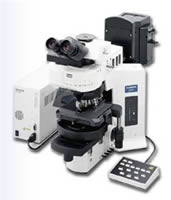Olympus BX61 Motorized Research Microscope
Olympus Updated: 2007-09-10The BX61 is a fully motorized research microscope built on the platform of the traditional upright frame. All major microscope functions can be completely automated, including focus, illumination, objective lens selection and filter wheels. A complete software command set allows for full computer control. The BX61 is an ideal platform for automated imaging systems demanding:
* Automation of repetitive tasks
* Automation of complex and time-sensitive operations
* Remote operation via networks or internet
* Timed sequences covering hours or days
At the heart of the BX61 is a research frame with a motorized internal focus drive. The motorized drive allows movement in 0.01 micron increments and is accurate enough for the most demanding z-axis movements and measurements. Driven by an external controller, the microscope frame is kept free of unnecessary wiring and power supplies, allowing the BX61 to occupy the footprint of a traditional microscope and minimizing excessive heat and electrical noise that can be detrimental to some experiments.
Beyond the focus drive the BX61 is a completely modular system, whereby motorized accessories can be added to meet the discrete needs of the individual user. All motorized accessories are driven by a master external system controller, the BX-UCB, a fact that allows these accessories to be attached even to the manual-focus BX51 microscope. Key functions that can be motorized include:
* Motorized 6-position nosepieces for standard or darkfield objectives.
* Motorized fluorescence filter turret and light shutter in illuminators that accept either 6 fluorescence filter cubes or 8 fluorescence filter sets. Excitation balancers attenuate excitation light for intensity balance in multi-color images.
* Motorized transmitted light condenser with 8-position turret and polarizer for DIC, phase contrast, darkfield and polarized light observation.
* 6-position filter wheels for lamphouse side, observation side and transmitted light mounting. Up to three wheels can be controlled simultaneously.
* Autofocus sensors for both reflected surfaces (laser based) and transmissive specimens (contrast based).
Dimensions
General Biological Brochure (PDF) (3MB)
BX51/BX61 Research System Microscope Brochure (PDF) (3.71MB)
BX52/BX62 Research Microscope Brochure (PDF) (1.25MB)
UIS Fluorescence Mirror Units Technical Specs (PDF) (448KB)
UIS Objectives for Life Science (PDF) (359KB)
Related Manuals
Olympus AX70/AX80 Microscopes
Olympus BX51WI/BX61WI Fixed Stage Research Microscopes
Olympus BXFM Focusing Module Microscope System
Olympus SZX7 Zoom Stereo Microscope
Olympus IX51 Inverted Microscope
Olympus MVX10 MacroView Macro Zoom Fluorescence Microscope
Olympus SZX10 Research Stereo Microscope
Olympus IX71 Inverted Microscope
Olympus SZX16 Research Stereo Microscope
Olympus IX81 Motorized Inverted Microscope
Olympus CKX31 & CKX41 Inverted Microscopes
Olympus Fluoview FV1000 MPE Multiphoton Microscope
